29 Camino de Santiago Symbols: The Scallop Shell & More
Disclaimer: Links on this page may be affiliate links. If you make a purchase after clicking a link, I may receive a small compensation to help power my site.
Find the meaning behind the symbols of the Camino like the famous scallop shell, yellow arrow, and others.
“What is the scallop shell meaning on the Camino?” This is just one of the frequently asked questions people have about the many symbols of the Camino de Santiago.
Before walking the Camino de Santiago, I had no idea about all of the special pilgrim symbols along the Camino routes. The only thing I knew was that you could attach a shell to your backpack!
But once I was on the Camino, I quickly found myself in what felt like another world with pilgrimage signs, symbolism, and language all of its own!
Certainly, from albergues and credentials to yellow arrows and cries of “Ultreya,” there are many fascinating Camino de Santiago symbols beyond the well-known Santiago de Compostela scallop shell.
To help you prepare for your walk, I’ve put together a detailed list of Camino de Santiago symbols, sayings, and other signs you’ll see along the way! From the shell and other symbols with historical origins to the many metaphors of the Camino, these are things you’ll want to know before starting!
Camino de Santiago Symbols: What’s the Main Symbol of the Camino Trail?
There are many symbols you’ll see on the Camino, but none of them is as popular as the scallop shell. In this section, we’ll review how the shell came to represent the Camino and how it’s used today.
1. Camino de Santiago Shell Symbol
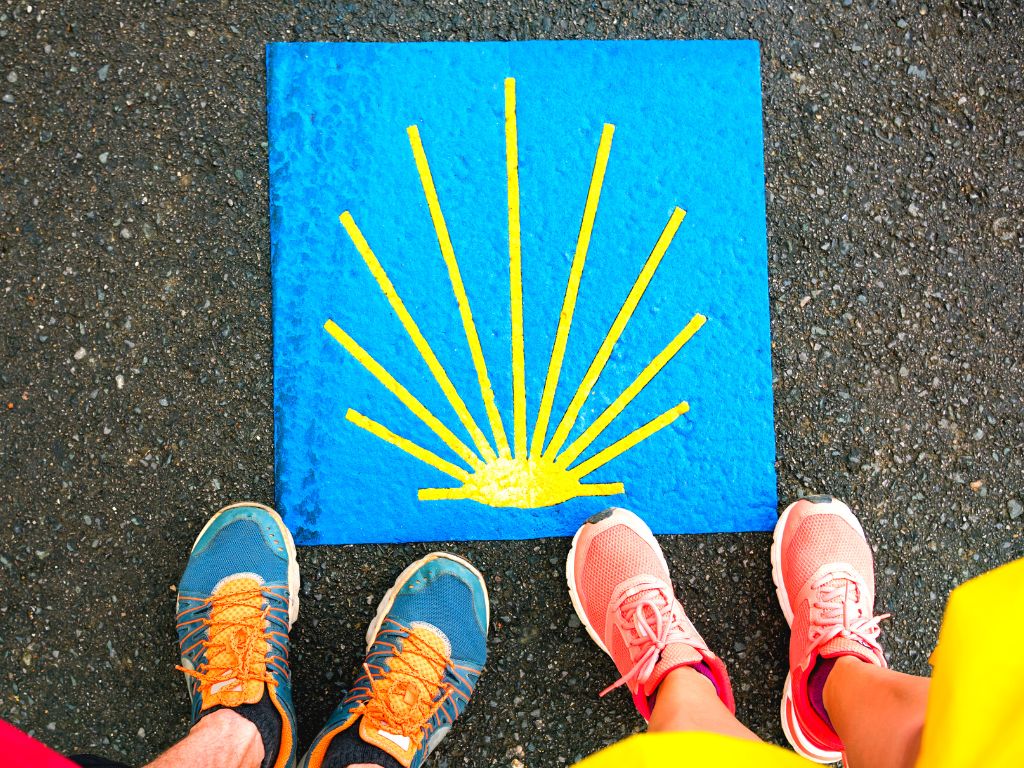
The famous Camino scallop shell (viera or concha) is the main symbol of the Camino de Santiago.
What does the Camino shell symbolize?
The Camino de Santiago shell is considered by many to be a metaphor. All the lines on it converge at the end representing the idea that pilgrims travel different routes from all over the world. But, all the trails lead to the tomb of Saint James in Santiago de Compostela.
What are the origins of the shell symbol on the Camino?
Well, there are actually several different stories and legends that try to explain this.
First off, some accounts say that St. James’ body was covered in shells when it was recovered was found along the Galician coast.
Others believe that the shell is simply evidence that medieval pilgrims walked all the way to Finisterre and the Atlantic Ocean, where there is an abundance of shells.
There is also evidence that scallop shells were used to drink water or eat food.
Others say that the disciples witnessed a miracle when they arrived on the Galician coast. A bride and a horse went into the sea in a freak accident but emerged unharmed and covered in shells.
How is the Camino shell used today?
You’ll find the Camino shell in Spain everywhere—adorning the milestones that mark the way, on pilgrim’s backpacks, and on all sorts of Camino memorabilia and Camino signage.
Whatever the origins of the Camino shell emblem, be sure to pick one up on the Camino! You may wear a shell to identify yourself as a pilgrim or choose to purchase one to commemorate the end of your journey (that’s what I did!).
Other Camino de Santiago Symbols
When you are out on the Camino pilgrimage trail, you will see many different symbols, signs, and images in addition to the famous Camino shell. You’ll also hear various sayings in English, Spanish, Latin, and more!
Here are some of the most common Camino symbols to watch out for:
2. Pilgrim
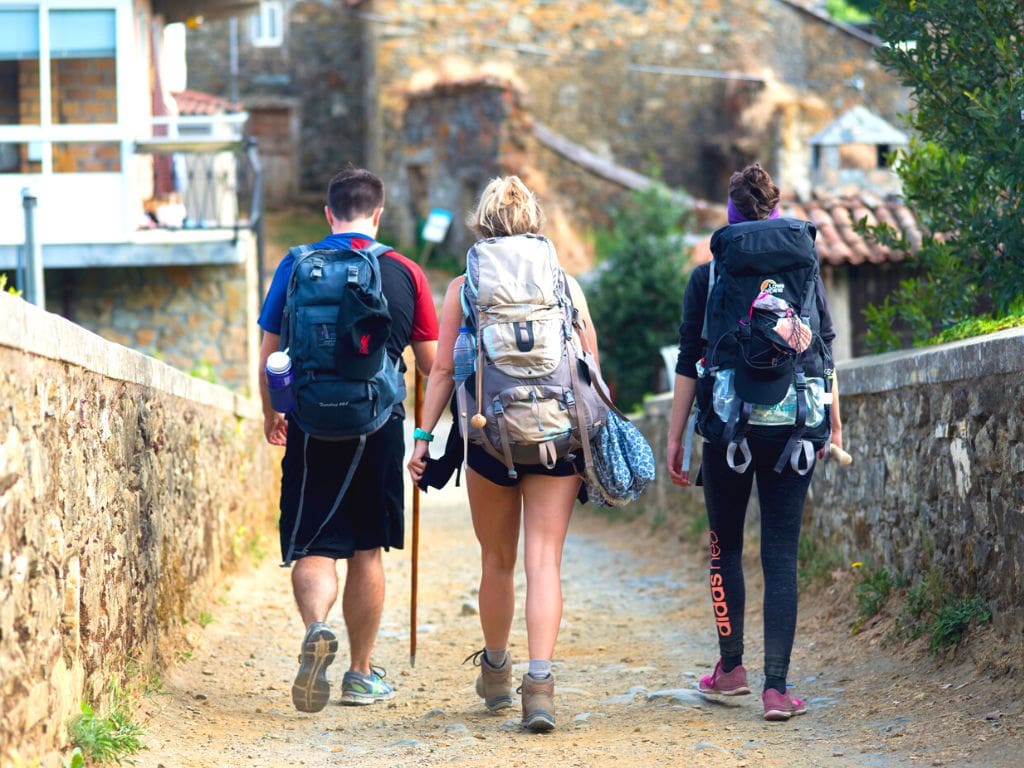
Anyone who walks the Way of St. James pilgrimage is called a pilgrim or peregrino/a in Spanish.
You’ll see pilgrim statues, images, and souvenirs throughout the Camino.
Medieval pilgrims wore simple robes and carried wooden walking sticks, a far departure from the modern pilgrim clothing and gear!
3. Camino de Santiago Yellow Arrow
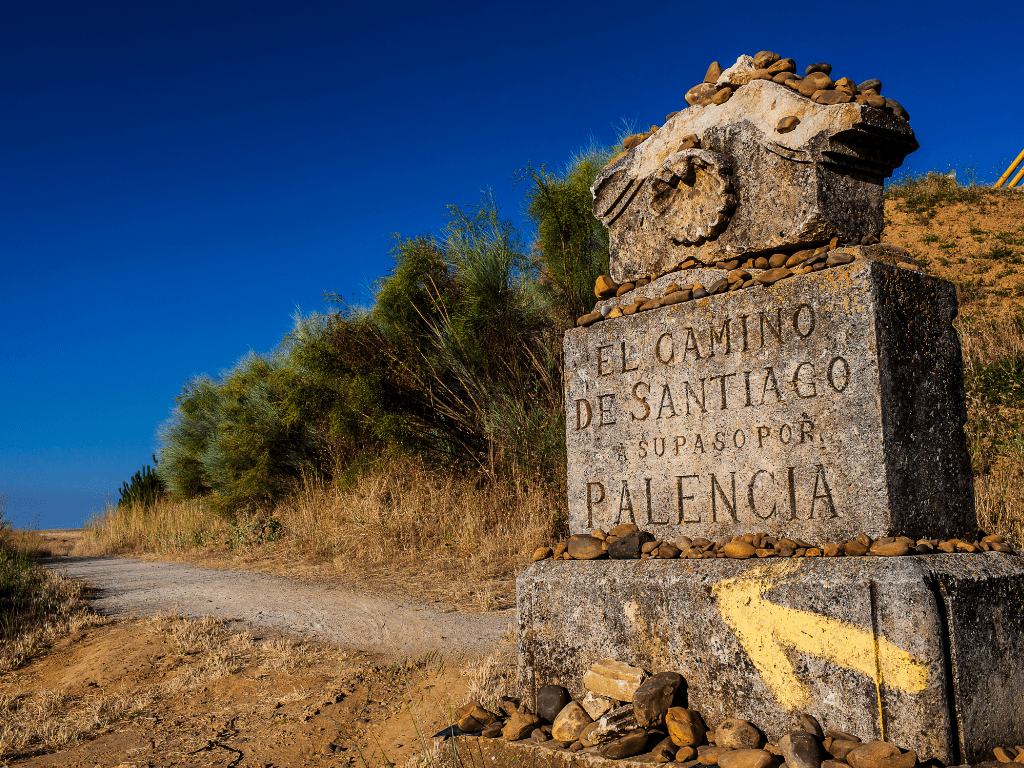
The yellow arrow marks the way to Santiago. Along with the shell, just follow the yellow arrow.
Along well-known routes like the Camino Frances, you’ll see the Camino arrow everywhere. On milestones, sidewalks, rocks, sides of buildings, signs, etc.
Legend has it that the parish priest of O Cebreiro began painting the way with yellow paint in the 1970’s. In 1987, it became an official Camino de Santiago symbol.
Funny enough, there’s no special meaning behind the color yellow. The priest used it simply because it was leftover (and, therefore, free)!
4. ¡Buen Camino!
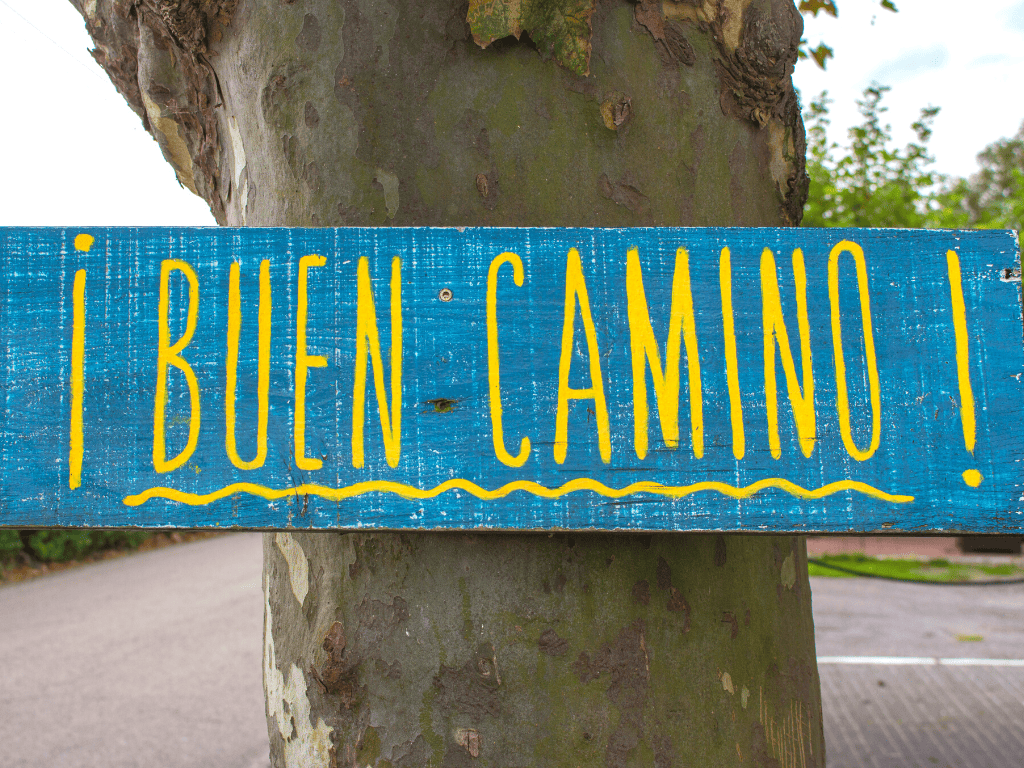
This pilgrim greeting is loosely translated, “Good Way!”
No matter what language you speak, this is a universal way to wish other pilgrims well on their journey. Use it liberally on the trail when you pass other pilgrims or when saying bye after a meal.
Locals will shout, “¡Buen Camino!” to you, too, as you pass by!
In French, the saying on the Camino is, “Bon chemin” and in, Portuguese, “Bom caminho.”
5. ¡Ultreya!
“¡Ultreya!” or “¡Ultreia!” is a joyful cry of pilgrims on the St. James Way. Although the full phrase in Latin is “¡Ultreia et suseia!,” you’ll often hear just the first word.
Used as an encouragement to other pilgrims, it’s meant to encourage others to go higher or beyond physically, spiritually, and mentally. You can also find beautiful jewelry with the inscription in Galicia.
¡Ultreya! is loosely translated to “Onwards and upwards!” “You can do this (past your limits)!” or “Let’s go (higher)!”
6. Credencial (Pilgrim’s Passport)
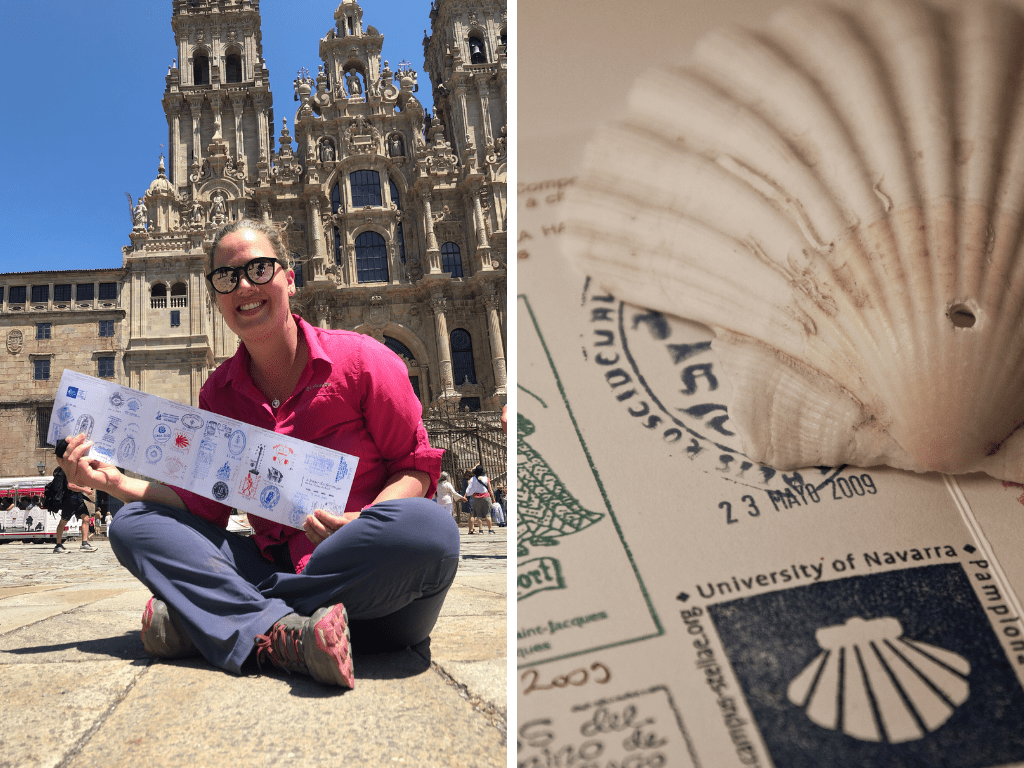
The credencial is the official Pilgrim’s Passport for walking the Camino de Santiago. Also called a credential, you’ll carry this with you to prove you accomplished the pilgrimage on foot.
At the beginning of the Camino, you purchase a credencial from an albergue, church, or even many tourist shops for about 2€.
Then, collect stamps (sellos) as you go from alberges, bars, churches, and well as other tourist attractions or post offices. (The credential gives you access to pilgrims’ accommodation, the pilgrims’ menu, and some other attractions—although it’s pretty obvious you’re a pilgrim, so you might not need to show it in the latter case!).
If you would like to get a Compostela and Certificate of Distance at the end of your journey, you must collect at least 2 stamps per day starting in Sarria.
7. Compostela
A Compostela is the official pilgrim’s certificate that the Pilgrim’s Office issues to pilgrims who have completed the Camino de Santiago for spiritual or religious reasons.
To get the Compostela, you must collect at least 2 stamps per day during the last 100 km of the journey which you need to complete by foot. (Alternately, you may do 200 km by bike or 100 km by horseback).
While it’s not required, the Compostela, printed on thick paper and written in Latin, is a lovely memento and symbol of your great achievement.
8. Certificate of Distance
A Certificate of Distance is an optional certificate that indicates your starting point, route, kilometers completed, and the dates of your pilgrimage.
You may purchase a Certificate of Distance at the Pilgrim’s Office in Santiago for 3€ ($3.50) in conjunction with the Compostela.
Although the Compostela is more official, the Certificate of Distance is more meaningful in my opinion as it records the exact details of your pilgrimage.
9. Albergue

An albergue is a pilgrim’s hostel. These hostels are set up all along the various Camino de Santiago routes to accommodate pilgrims’ needs. You can also find good albergues in Santiago de Compostela.
While albergues can vary in size and amenities, they usually have multiple rooms filled with bunk beds. Pilgrims can book one night’s stay in a bunk and use all the albergue facilities by showing their pilgrim’s passport (more on the passport, below).
These facilities often include a kitchen, laundry area, lounge area, bicycle parking, and more.
Learn everything you need to know about albergues along the Camino.
10. Hospitalero/a
The hosts at the albergues are called hospitaleros/as.
Hospitaleros are there to welcome you after a long day’s walk, register you, stamp your credencial, and show you around the albergue.
Depending on the albergue, they may also cook communal meals, do loads of laundry, etc.
Never be afraid to ask the hospitaleros for advice or help. They are there to serve, and happily so—some hospitaleros are even volunteers!
11. Bar

A bar along the Way of St. James is a small café that usually has outdoor seating and a bar or counter.
There are bars all along the Camino path where pilgrims can stop to rest and recharge.
Bars serve drinks such as coffee, tea, orange juice, wine, and beer. They also often serve light fare such as toast with ham, tortilla de patata (Spanish potato omelet), or Spanish pastries—what you’ll come to know as typical food along the Camino de Santiago.
Typically, you order and pay at the bar. Then, the bartender will bring your order out to you when it’s ready.
In contrast, in larger cities and at restaurants in the evenings, it’s common to sit down for table service.
12. Pilgrim’s Menu

Each evening, you can order a three-course Pilgrims Menu (Menú del peregrino) at restaurants on the Camino.
Consisting of a starter, main, dessert, bread, and wine, it’s indescribably nice to enjoy a full meal in a cozy setting after a long walk.
Feel free to eat alone or with some other pilgrims. Don’t be afraid to fill up, either. You have a long walk ahead the next day!
The prix-fixe pilgrim’s meal typically costs 10-12€ ($12-14).
13. Tarta de Santiago
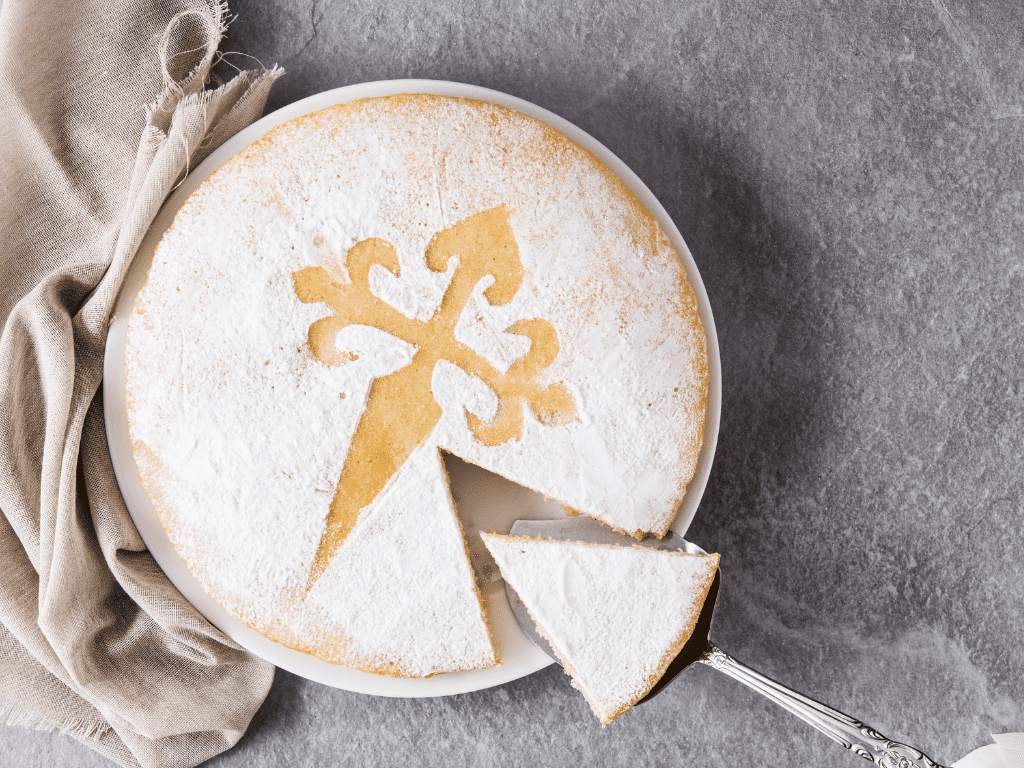
Tarta de Santiago, or St. James Cake in English, is a traditional cake from Galicia. Don’t skip ordering it in bars and restaurants in Galicia. (I even tried a chocolate version!)
With a dry texture, the isn’t overly sweet and is made of gluten-friendly almond flour!
14. Milestone
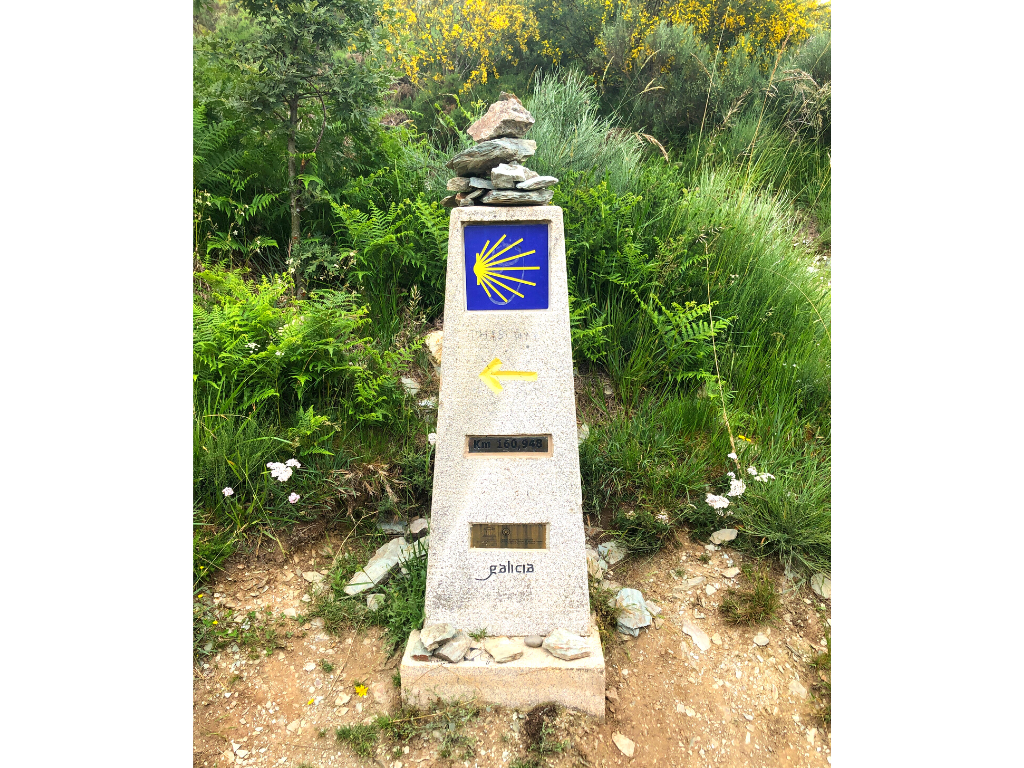
Milestones are beautiful concrete or stone markers adorned with blue and yellow shell tiles, the Camino de Santiago logo.
Placed every 1 km (closer together in Galicia), the milestone markers indicate the remaining distance to reach Santiago de Compostela.mean
15. Cruceiro

One of the Camino symbols that you’ll see often are cruceiros. These are magnificent stone crosses and/or crucifixes. Standing tall, they were said to protect and direct travelers on their way to Santiago.
Cruceiro is a Galician word meaning an intersection. Therefore, you’ll find most of these crosses where two or more roads intersect to help mark the way.
Each cross is different and often has figures on each side including the crucified Christ, the Virgin Mary, and St. James the Apostle. Jesus faces south and the opposing figure faces north so that ancient pilgrims knew which way to go.
16. Piles of stones
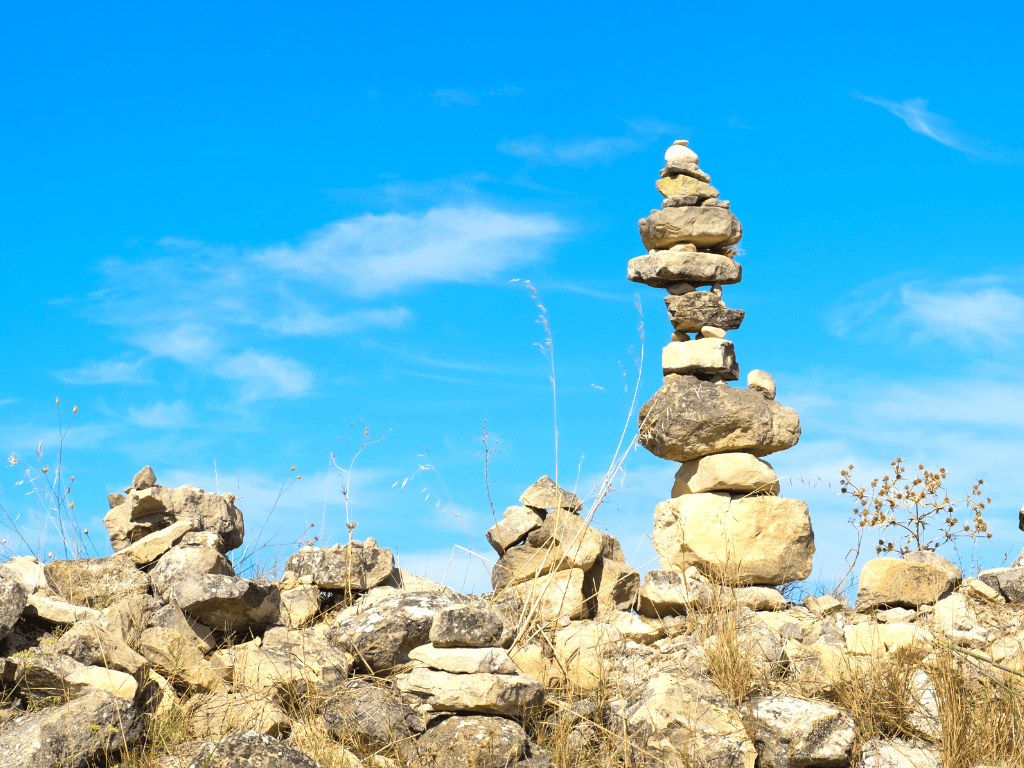
On top of some milestones, stone crosses, and other places along the route, you’ll find stacks of stones called cairns, a word originating from Gaelic.
Traditionally, these stacks have been used to mark paths for hikers or to mark burial grounds.
However, these piles of stones seem to have a more spiritual significance in modern times.
Just some of the reasons pilgrims build cairns are to say a prayer, leave a reminder, drop a stone for a loved one, feel connected, or encourage others.
17. The Iron Cross
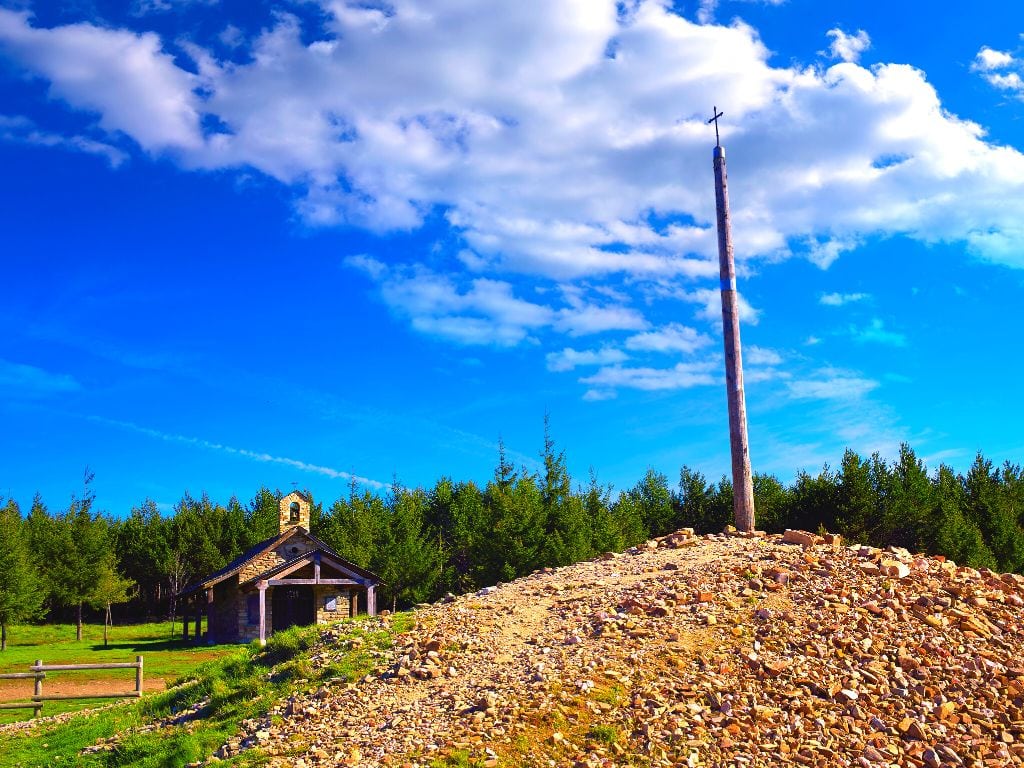
The Iron Cross, or Cruz de Ferro (also Cruz de Hierro), is a large iron cross on the Camino de Santiago. It’s located at the highest point on the Camino Frances between Foncebadón and Manjarín.
The Iron Cross consists of a small park with a tall wooden pole surmounted by an iron cross
It’s traditional for pilgrims to leave a stone as a token of leaving their burdens, sorrow, or sin at the foot of the cross.
18. Walking Stick w/Gourd
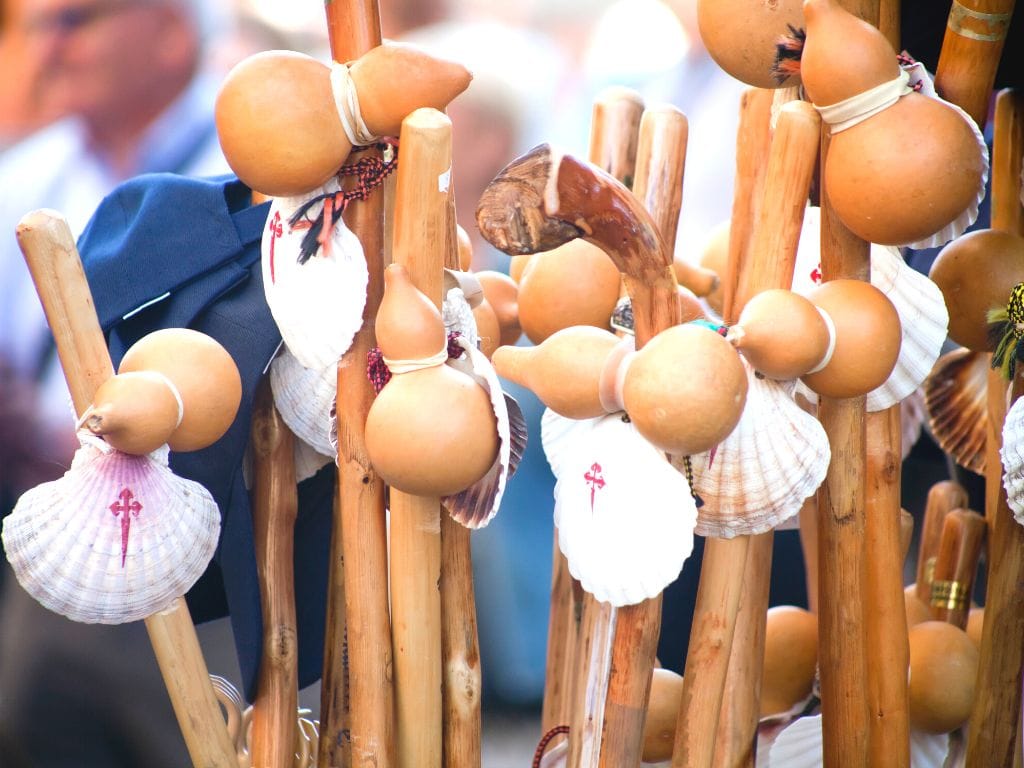
For centuries, pilgrims (and hikers in general, for that matter) have used wooden sticks or staffs to relieve impact and help keep their pace.
Most modern pilgrims opt for a pair of trekking poles, but you’ll still see the traditional walking sticks (bordón or cayado) for sale at gift shops.
Many of the pilgrim’s staffs are adorned with a gourd. The gourd (i.e. squash or pumpkin) was used to carry water!
19. Camino Boot
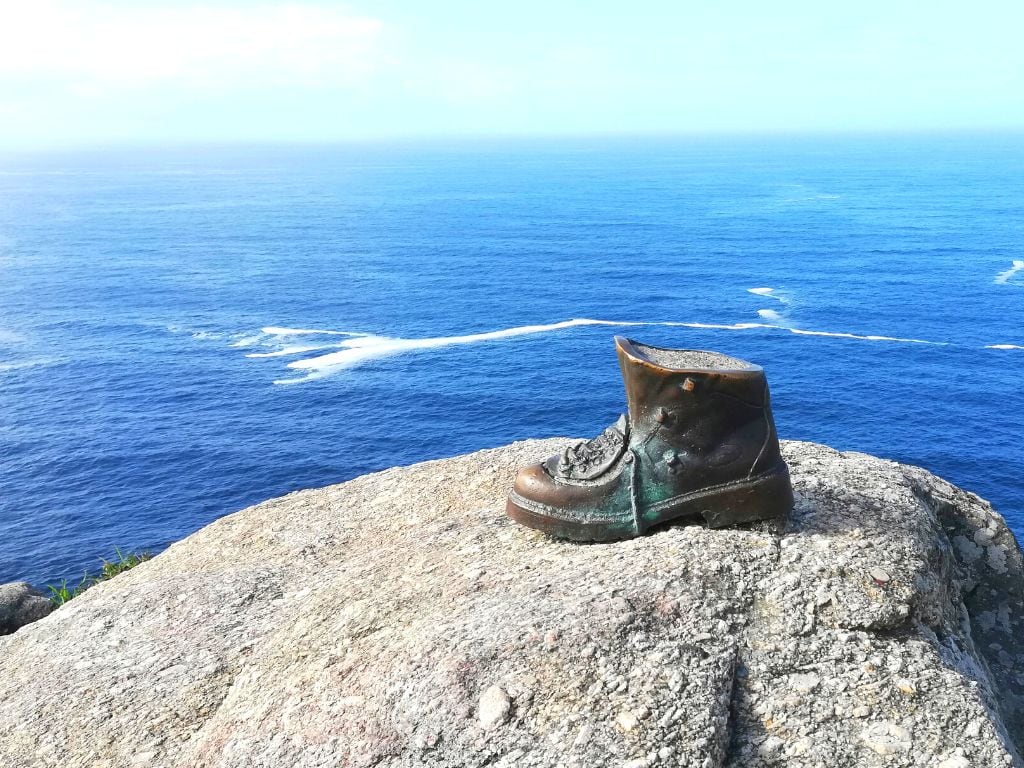
For many years, pilgrims have left their boots at the end of their journey. As you can imagine, this leaves a lot of boots for locals to clean up!
Originally installed in memory of a pilgrim who drowned in Finisterre, there’s a bronze boot installed in Cape Finisterre. Today, it’s seen as a tribute to all the pilgrims who have completed their Caminos.
20. Triskele
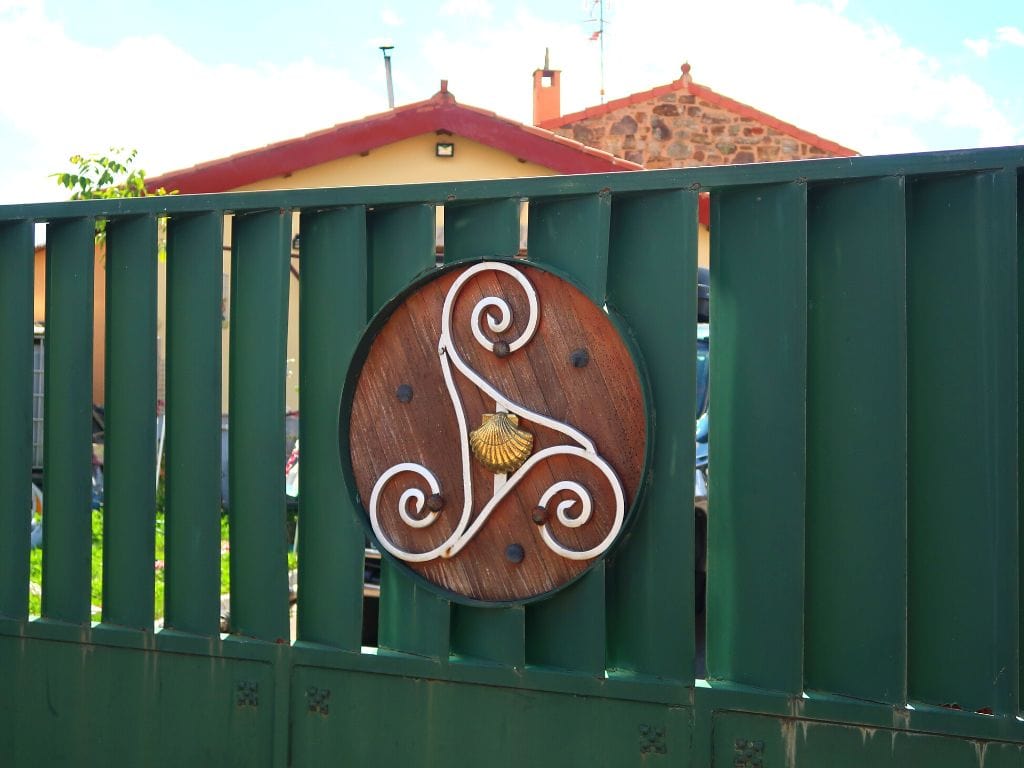
As you get closer to the finish of the Camino in Galicia, you’ll see more and more Celtic symbols. This is because a Celtic tribe once settled in what is now modern-day Galicia. Evidence of Galicia’s Celtic past is all around in the symbols, language, tradition, and culture of Galicia.
One of these symbols is the triskele (a word derived from Greek). It’s a design with three spirals that signify the cycles we go through as well as constant evolution.
The triskele reminds pilgrims to continue growing and changing after the profound experience of walking the Camino.
21. Pilgrim’s Mass & Pilgrim’s Blessing
Along the Camino, there are many Catholic churches, chapels, and hermitages indicative of the pilgrimage’s Catholic roots.
Although they are not all open, you will find some churches that hold mass for pilgrims in the evenings.
These services are a treat for the religious and non-religious alike. You will often recite a lovely pilgrim’s prayer and receive a blessing from the priest—in Spanish, of course!
Daily pilgrim’s mass is held at 12pm in the Cathedral of Santiago de Compostela and is a highlight for many pilgrims.
22. The Botafumeiro
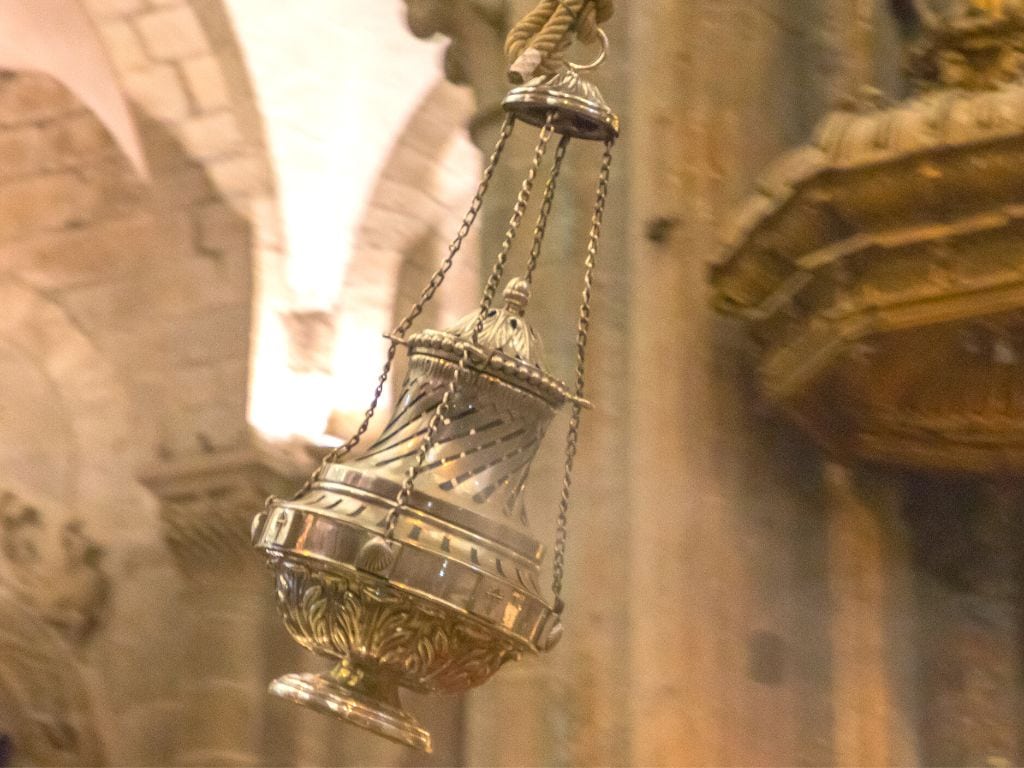
The enchanting botafumeiro inside the Cathedral of Santiago is a large silver-plated censer (incense burner) that weighs more than 132 lbs (60 kilos).
Its use was historically twofold: a spiritual purifier for those who completed the path and to hide the stinky smells of pilgrims after their long walks.
Today, the censer swings only on certain dates of the year, including holidays and when the feast of Santiago Apóstol is celebrated (July 25th).
23. St. James
The namesake of the Camino is St. James the Apostle, Santiago in Spanish. After St. James’ body was reportedly found, the church created a small chapel to house his remains. Later, the great Cathedral was built in its place.
For centuries, pilgrims have come to Santiago to pay homage to the Saint and the many pilgrims who walked before. However, today, pilgrims come for many reasons—mental, physical, touristic—aside from religious.
You’ll see St. James depicted all along the Camino.
24. St. James Cross

This cross of St. James is a Latin cross that looks similar to a sword or dagger—the origins of which may date back to the Crusades!
The cross is painted red to represent Jesus’s blood and sacrifice on the cross.
It’s common to see pilgrims wearing St. James cross pins or pendants. The cross is also painted on many of the shells that pilgrims use to adorn their packs.
25. The Tomb of St James
Inside the Cathedral of Santiago de Compostela, you may visit the tomb of St James. Here, it’s said that the remains of the apostle and two of his disciple lay.
Aside from the tomb, there’s also a statue of St. James that people wait in line to touch!
26. Holy Year
The Jacobean (Xacobeo) Year or Holy Year occurs whenever July 25th occurs on a Sunday. This tradition began in 1121, the year in which the Pope gave the Church of Santiago the ability to grant total forgiveness to pilgrims who visited Santiago’s tomb on holy years.
Jacobean Years fall ever 6, 5, 6, and 11 years, making them a rare event and a very busy time on the Camino de Santiago. The next Holy Years are in 2027 and 2032.
27. Holy Door (Porta Santa)
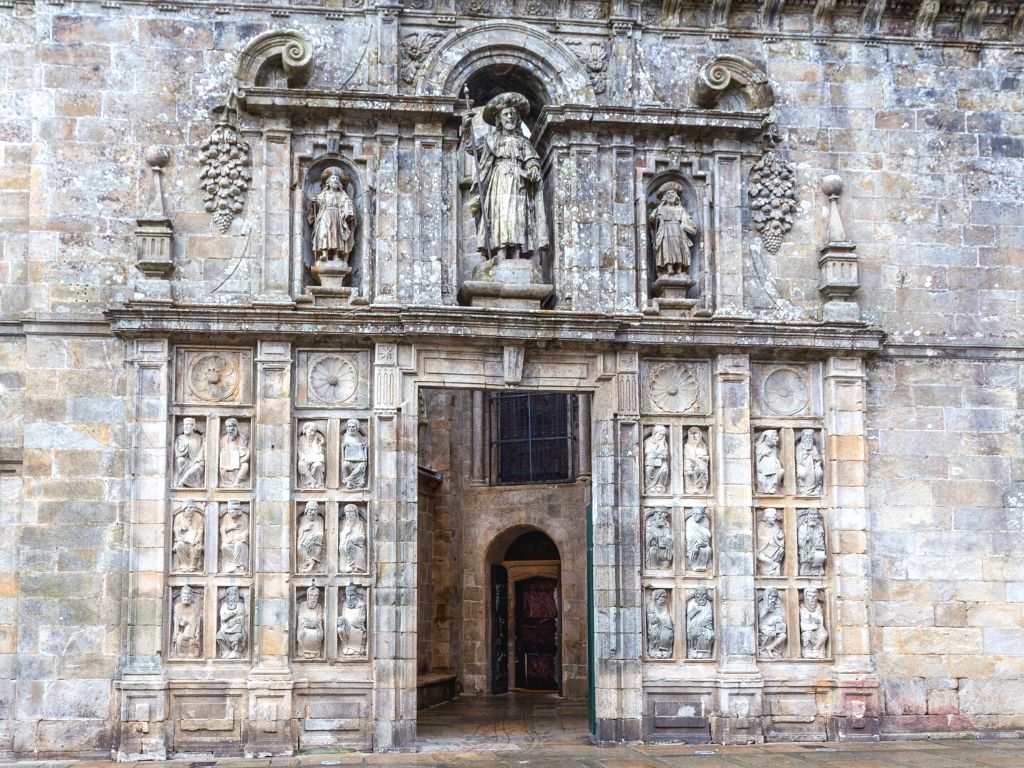
The Holy Door, or Porta Santa, is located on the backside of the St. James Cathedral in Santiago de Compostela. What makes this door so significant is that it only opens during Holy Years!
It’s said that believers, pilgrims, and curious who enter through the Holy Door will be granted absolution from their sin as customary with Xacobeo year celebrations.
28. St. James Day
The Feast of Saint James, also known as Saint James’ Day, is a commemoration of the apostle James. It’s celebrated every year on July 25th in the Roman Catholic church and the Anglican church.
St. James Day is Santiago de Compostela’s biggest largest annual festival. If you attend during that time, you can enjoy mass with the swinging botafumeiro, processions, and fireworks.
Wondering why St. James Day is July 25th? Well, July 25th is known to be the day that St. James the Apostle was beheaded in Jerusalem!
29. The Codex Calixtinus
The Codex Calixtinus is a 12th-century document that includes background detail and advice for pilgrims following the Way of Saint James to the shrine of the apostle Saint James the Great.
Compiled by Pope Calixtus II, the collection of 5 books includes sermons, records of miracles, liturgical texts, and music. You can also find descriptions of the Camino route and the customs of the local people.
The Codex Calixtinus is also called the Liber sancti Jacobi.
Camino de Santiago Symbols: FAQ
What is the symbol that hikers follow along the Camino?
The pilgrimage symbol that hikers follow along the Camino de Santiago is the yellow arrow. The arrows point the way to the cathedral in Santiago de Compostela, Spain. The arrows are everywhere: sidewalks, signposts, fences, walls, sides of buildings, rocks, and more.
What is the Camino marked with and why?
The Camino de Santiago is marked with yellow arrows and milestones, many times decorated with shells. These all help to indicate the way to Santiago de Compostela so that pilgrims don’t get lost. The yellow arrows were first added by a priest in the 70s who wished to help pilgrims know which direction to go. The milestones indicate the distance left to the end of the pilgrimage.
Why is the scallop shell the symbol of the Camino?
While the origins of the scallop shell symbolism are unclear, medieval pilgrims likely picked up a shell when they reached the Galician coast. In that way, it became one of the first Camino souvenirs. The shell is also a metaphor. Its lines represent the different routes pilgrims take from around the World to get to Santiago de Compostela.
Why is the scallop shell the symbol of St James?
According to tradition, the scallop shell has become the symbol of St James because when the apostle’s body was recovered on the shores of Galicia, it was covered in scallop shells.
Where can I get a Camino shell for backpack?
You can buy a scallop shell for your backpack at any tourist shop along the Camino de Santiago, whether you want to get one when you start in Sarria or as a commemorative item in Santiago de Compostela. You can also find a Camino shell for sale online.
What is the spiritual Camino de Santiago?
The spiritual Camino refers to the inner journey pilgrims undertake when walking the Camino. However, when pilgrims refer to the spiritual Camino, they may be referencing the spiritual variant of the Camino Portugues. The spiritual variant of the Camino Portugues is an alternative route to Santiango beginning in Pontevedra. It follows the path where James the Great’s remains passed on the way to their final resting place in the Santiago Cathedral.
What does the stone represent along the Camino?
Stones can represent many different things along the Camino. Two common reasons people carry a stone are to symbolize a burden or sorrow they want to release or a stone for a loved one that couldn’t be with them on the journey.
Why do people leave stones along the Camino?
There are many reasons why people leave stones along the many Camino routes. For instance, pilgrims leave stones on the Camino to mark the way for others, to say, “I was here,” or as part of a prayer.
Where do you leave your rock on the Camino?
While it’s not a requirement to leave a rock on the Camino, many people leave a rock at the Iron Cross (the Cruz de Ferro). This is the highest point on the Camino Frances where you’ll find a tall cross surrounded by a mount of rocks. Leaving a rock at the Iron Cross was depicted in the popular Camino movie The Way.
What is the meaning of Cruz de Ferro?
The Cruz de Ferro or Iron Cross is an iconic symbol on the Camino Frances. The Cruz de Ferro represents the spiritual renewal that many pilgrims seek through their journey. It’s said that you can leave a stone on the pile to leave your worries, pain and sorrow, hardships, and burdens behind by placing them symbolically at the foot of the cross.
How do you wish someone a good Camino?
To wish someone a good Camino, you say, “¡Buen Camino!“
What is the motto of the Camino de Santiago?
There are several mottos of the Camino de Santiago. The most common saying of the Camino is “¡Buen Camino!” which roughly translates to “Good way!” in English. Another popular motto is “Ultreia e suseta.” This is a pilgrim cry meaning, “onwards and upwards!”
What is the Camino pilgrim’s prayer?
You’ll recite this ancient pilgrim’s prayer at pilgrim masses on the Camino de Santiago, or something similar:
O God, who brought your servant Abraham
out of the land of the Chaldeans,
protecting him in his wandering across the desert,
we ask that you watch over us, your servants,
as we walk in the love of your name to insert your destination here.
Be for us our companion on the walk,
Our guide at the crossroads,
Our breath in our weariness,
Our protection in danger,
Our home on the Camino,
Our shade in the heat,
Our light in the darkness,
Our consolation in our discouragements,
And our strength in our intentions.
So that with your guidance we may arrive safe and sound
at the end of the road and enriched with grace and virtue
we return safely to our homes filled with joy.
In the name of Jesus Christ our Lord, Amen.
Apostle Santiago, pray for us.
Santa Maria, pray for us.
Who is the patron saint of El Camino?
Saint James is the patron saint of pilgrims, Spain, and Galicia. The Camino de Santiago is named for him. (Santiago means James in English). Thus, in English the pilgrimage is called the St. James Way. St. James’ feast day is celebrated annually on July 25th.
Camino de Santiago Symbols: ¡Buen Camino!
There you have it! As you can see, the Camino de Santiago has many special symbols, sayings, metaphors, and signs beyond the recognizable Santiago de Compostela shell and yellow arrow!
Whether you walk alone or join one of the guided tours, be on the lookout for these Camino symbols when you start your pilgrimage. ¡Buen Camino!”
Camino de Santiago Travel Guide
🏨 Where should I book accommodations for the Camino?
Search Booking.com hotels, hostels, B&Bs, and guesthouses on the Camino.
🚉 How do I buy train or bus tickets in Spain?
Search for train tickets in Spain on Omio which will show you the best selection of trains and buses. Trainline and Busbud are also great to cross-reference, as no one platform has every route!
📱 Where can I get cellular data for Santiago de Compostela?
Try using Airalo, the world’s first eSIM store! Download, and install your eSIM, and get connected as soon as you land.
📃 Should I buy travel insurance for the Camino de Santiago?
Yes! Protect your investment from trip interruptions to unexpected injuries — compare rates on Travel Insurance Master and SafetyWing (which has some of the cheapest rates when you subscribe to a 1+ Month plan).
🎒 How can I book backpack transport on the Camino?
To arrange for backpack transfer on the Camino, check with your Jacotrans.
✈ What are the best sites to book flights within Spain?
Search Skyscanner for best flights that other search engines miss!
🏙 Where do I find the best Santiago de Compostela tours?
Search for top-rated Santiago de Compostela tours (with reviews!) on Viator and/or Get Your Guide.
🥾 What should I pack for the Camino de Santiago?
Download the Camino de Santiago packing list.
Go to our resources page for more booking tools we use to plan our trips.
Useful Camino de Santiago Articles
Planning a trek along the Way of St. James? Check out some of our top articles:
